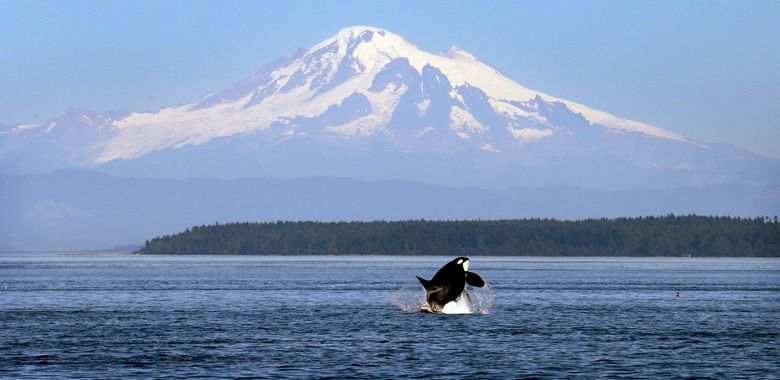Thanks But No Tanks (Investigative Report)
As a
native to the Pacific Northwest, I have learned over the years that those who
call this place home are incredibly fortunate to have such vast amounts of
nature and wild life. The killer whale (or Orca) has become a marine life icon
in this area, they are known to be playful, intelligent and very social
animals.


Decades
ago the attitudes towards Orcas were very different, they were greatly feared
and were thought to be violent and dangerous. The overall public knew little
about the nature of these creatures, but as their name “killer” whale implies,
they sound very unsafe. Because of the lack of knowledge and overwhelming fear,
they were hunted and eventually taken into captivity. SeaWorld is one of the
most popular Orca attractions in the world and they claim to treat their whales
fairly and keep them in top health condition but even if this is true, many
people feel as though keeping whales in captivity is inhumane.
Killer
whale captures for exhibition purposes began in the Pacific Northwest in 1965, the Center for Whale Research tells us
the story of one of the first captures. Ted Griffin, the owner of the Seattle
Public Aquarium, dreamed of taking care of a killer whale; he was convinced
that a friendly relationship was possible. Griffin bought his first whale for
$8,000 and named him Namu. He wanted to show that killer whales were not
the dangerous predators that everyone thought they were; to show this to the
thousands of tourists coming to see Namu, Griffin decided to swim with him. He
studied Namu’s every move and attitude, Griffin eventually hopped on his back
and he reported that, "It was as if my every conscious wish became the
whales command." They were inseparable and performed together until Namu
got a bacterial infection leading him to his death. Ted Griffin had great
intentions in showing the public how friendly and intelligent killer whales
truly were yet the idea of capturing a helpless animal to use them for
commercial entertainment is truly heart breaking.
According to the Whale and Dolphin
Conservation (WDC, a non-profit organization) there are currently a total
of 56 orcas held in captivity, 23 wild-captured plus 33 captive-born in at
least 12 marine parks around the world. At least 150 orcas have been taken into
captivity from the wild since 1961 and 127 of these orcas are now dead.
SeaWorld states that they are
committed to animal care, conservation, rescue and research of animals in their
park and in the wild. Their legacy is to help animals that are orphaned, ill,
injured or in need of expert care and the goal for every animal rescued is to
successfully rehabilitate and return it to the wild. “Due to the world-class
veterinary care that the whales receive they are not just healthy but they are
thriving, and their lifespans are equivalent with whales in the wild,”
according to SeaWorld. SeaWorld also states that they have not captured a whale
in 35 years due to their ground-breaking reproduction research program.
SeaWorld claims to have top veterinary care for their animals but the
information feed to their guests have been proven false by many other marine
biologists…
Tilikum was the main breeder at SeaWorld and was used to inseminate all
female whales at the facility. Currently, 54% of the whales in SeaWorld’s
collection now have Tilikum’s genes even though he has shown significant signs
of aggression.
With their new breading program, SeaWorld welcomed a new baby Orca, the calf soon started defying her mother and creating disruptions in the shows. SeaWorld
made the decision to split the family apart and move the baby whale to another
park when she was just four and a half years old. Once the baby was on a truck
on the way to the airport, her mother stayed in the corner of the pool,
shaking, screeching and crying. In the film Blackfish
a former trainer John Hargrove noted the
vocals of the crying mother when her calf was taken from her he and how they had never
heard them before so SeaWorld brought in senior researcher scientists to
analyze the vocals; they were long range vocals, and she was looking for her
calf. “How can anyone look at that and think that that is morally acceptable?”
SeaWorld has created an environment that greatly inspired many people to
go out and to learn about marine life. Without these parks we would not know
what we know today about Orca’s and all the other type of marine life. I do
believe that SeaWorld had great intentions to keep all of their animals happy
and healthy, but with the Orca’s something went extremely wrong. Now we know
that these animals love to swim and learn until they ripped
away from their families, put into a small pool with other strange whales and
told what to do in order to be fed. These animals are highly intelligent and it
should not be normalized for them to be put in concrete pools. Another former
SeaWorld made a statement about Tilikum that says it best, “…He’s killing not
to be a savage. He’s not killing because he’s just crazy. He’s not killing
because he doesn’t know what he’s doing. He’s killing because he’s frustrated,
and he’s got aggravations and he doesn’t know how to—he has no outlet for it.”
With the severely declining health of Tilikum and an overall outrage from
the public, we can finally see a light at the end of the tunnel. In recent
events, SeaWorld
has announced their last generation of whales and that they will no longer
breed Orcas.

Comments
Post a Comment